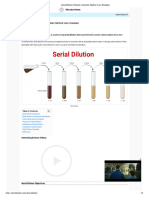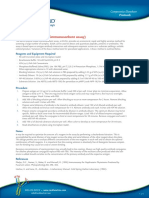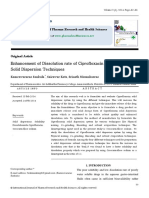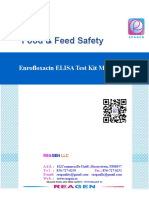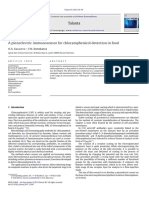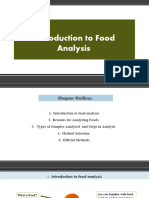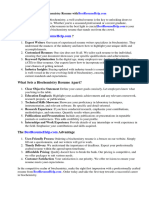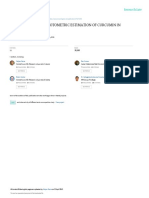A Lamar Blue
A Lamar Blue
Uploaded by
Ruan JinglinCopyright:
Available Formats
A Lamar Blue
A Lamar Blue
Uploaded by
Ruan JinglinCopyright
Available Formats
Share this document
Did you find this document useful?
Is this content inappropriate?
Copyright:
Available Formats
A Lamar Blue
A Lamar Blue
Uploaded by
Ruan JinglinCopyright:
Available Formats
alamarBlue® Cell Viability Reagent
Catalog nos. DAL1025, DAL1100
Table 1. Contents and storage information.
Material Amount Concentration Storage* Stability
When stored as directed
• 2–8˚C
25 mL (Cat. no. DAL1025) 10X, ready-to-use this kit is stable until the
alamarBlue® reagent • Protect from
100 mL (Cat. no. DAL1100) solution expiration date printed on
light
the product.
Number of assays: Sufficient reagent is supplied for 25 microplates (2,500 assays) for Cat. no. DAL1025 or 100 microplates (10,000
assays) for Cat. no. DAL1100 based on the protocol below.
Approximate fluorescence excitation/emission maxima: 540–570/580–610 nm. If using an instrument with a monochrometer, use
560/590 nm. Peak excitation/emission are 570/585 nm.
Absorbance maxima: 570 nm (additionally monitor 600 nm as a reference).
Introduction
Cell health can be monitored by numerous methods. Plasma membrane integrity, DNA
synthesis, DNA content, enzyme activity, presence of ATP, and cellular reducing conditions
are known indicators of cell viability and cell death. alamarBlue® cell viability reagent
functions as a cell health indicator by using the reducing power of living cells to quantitatively
measure the proliferation of various human and animal cell lines, bacteria, plant, and fungi
allowing you to establish relative cytotoxicity of agents within various chemical classes. When
cells are alive they maintain a reducing environment within the cytosol of the cell. Resazurin,
the active ingredient of alamarBlue® reagent, is a non-toxic, cell permeable compound that
is blue in color and virtually non-fluorescent. Upon entering cells, resazurin is reduced to
resorufin, a compound that is red in color and highly fluorescent (Figure 1). Viable cells
continuously convert resazurin to resorufin, increasing the overall fluorescence and color of
the media surrounding cells.
alamarBlue® cell viability reagent is used to assess cell viability by simply adding the 10X,
ready-to-use solution to mammalian or bacterial cells in culture media (Figure 2). There is
no requirement to aspirate media from cells or place cells in minimal media. Consequently,
alamarBlue® reagent can easily be used in a single tube or microtiter plate format in a “no-
wash” fashion. Simply add alamarBlue® reagent as 10% of the sample volume (i.e., add 10 µL
alamarBlue® reagent to 100 µL sample), followed by a 1–4 hours incubation at 37ºC. Longer
incubation times may be used for greater sensitivity without compromising cell health (Figure
3 and see Frequently Asked Questions). The resulting fluorescence is read on a plate reader
or fluorescence spectrophotometer. Alternatively, the absorbance of alamarBlue® reagent
can be read on a spectrophotometer. Finally, results are analyzed by plotting fluorescence
intensity (or absorbance) versus compound concentration.
Revised: 16–July–2008 | MP 01025
alamarBlue® reagent can detect as few as 50 cells per well in a 96-well plate. To evaluate
the sensitivity of alamarBlue® reagent, a serial dilution of HUVEC cells was performed in a
black, clear-bottom 96-well plate. Cells were then treated with alamarBlue® reagent and the
fluorescence was measured 40 minutes and 18 hours later. After 40 minutes, the fluorescence
intensity of alamarBlue® reagent was directly proportional to cell number in the range of
500–50,000 cells. After 18 hours, the fluorescence intensity of alamarBlue® reagent was
directly proportional to cell number in the range of 50–5,000 cells, leading to more sensitive
detection (Figure 3).
Figure 1A. alamarBlue® works as a cell viability and proliferation indicator through the
conversion of resazurin to resorufin. Resazurin, a non-fluorescent indicator dye, is converted
to highly red fluorescent resorufin via reduction reactions of metabolically active cells. The
amount of fluorescence produced is proportional to the number of living cells.
Figure 1B. Absorbance and fluorescence emission spectra of
resorufin.
Figure 2. alamarBlue® cell viability assay protocol. A 96-well plate containing the cells and the compounds to be tested is prepared using standard methods.
alamarBlue® reagent is added directly to each well, the plates are incubated at 37°C to allow cells to convert resazurin to resorufin, and the fluorescence (or absorbance)
signal is measured. Results are evaluated by plotting the fluorescent (or absorbance) signal versus compound concentration. This depicts an assay carried out in a
96-well plate, but the procedure is readily adaptable to other formats as well (including 384-well plates and tubes of various volumes). If tubes are used, the sample
is transferred to a cuvette prior to spectrophotometric analysis.
alamarBlue® Cell Viability Reagent | 2
A B
Figure 3. Linearity and sensitivity of alamarBlue® reagent on HUVEC cells. A) alamarBlue® reagent is linear over the range from ~500 to 50,000 cells after a 40-minute
incubation of cells with reagent. B) The same 96 well plate of cells was read after 18-hour incubation and shows the sensitivity of alamarBlue® reagent. The horizontal
line at ~450 RFU represents the background fluorescence in the experiment, which was calculated as three times the standard deviation of the “no cell” control. The inset
graph shows alamarBlue® to be linear over the range from 50 to 5,000 cells/well after 18 hour incubation of cells with reagent. Error bars are shown as ±SEM.
Advantages of alamarBlue®
Reagent The alamarBlue® assay offers the following advantages over conventional spectrophotometric
or radioactive cytotoxicity assays:
Time Savings: Ready-to-use, add-and-read format reduces sample handling steps.
Multiple Formats: Suitable for use with eukaryotic or prokaryotic cell types, single tube or
microtiter plate assay, and data recorded using fluorescence or absorbance measurements.
Endpoint or Kinetic Reads: Perform endpoint or kinetic assays for analysis of cellular viability
or compound toxicity.
Convenient: Supplied as a ready-to-use solution for high-throughput screening in 96- or 384-
well formats.
Multiplexing: Compatible for multiplexing with other assay methods such as CyQUANT® NF
Cell Proliferation Assay Kit (Cat. no. C35006) for detecting nucleic acid as a viability indicator
(Figure 4).
Note: You may need to empirically determine the ability to multiplex with CyQUANT® NF
Cell Proliferation Assay Kit based on the cell type used.
Inexpensive: Invitrogen’s alamarBlue® reagent is formulated as 10X as opposed to 5X which
allows you to perform twice the assays as compared to competitor’s products.
Safe: Non-toxic reagent allows real-time monitoring of cell metabolism and viability1
and does not use any hazardous solvents, or require disposal of scintillation cocktail and
radioactive waste.
alamarBlue® Cell Viability Reagent | 3
A B
Figure 4. Multiplexing of alamarBlue® reagent with CyQUANT® NF. HepG2 cells were incubated with tamoxifen for 24 hours prior to the addition of A) alamarBlue®
reagent B) CyQUANT® NF, or C) alamarBlue® reagent and CyQUANT® NF. The indicated IC50 values demonstrate that alamarBlue® reagent can be multiplexed with other
cytotoxic indicators and still give accurate results.
Before You Begin
Materials Required but Not
Provided • Mammalian or bacterial cells in appropriate medium
• Appropriate 96- or 384-well plates
• Optional: 3% SDS in phosphate buffered saline (PBS), pH 7.4
Preparing Cells Mammalian Cells—Adherent: Plate mammalian cells in a cell culture flask or dish, and
allow cells to adhere and grow for approximately 4–24 hours at 37°C and 5% CO2 before
proceeding with the assay.
Mammalian Cells—Suspension: Plate mammalian cells in a cell culture flask or dish, and
use cells immediately for the assay or allow cells to grow for up to 24 hours at 37°C and 5%
CO2 before proceeding with the assay.
Bacterial Cells: For details, see references 2 and 3.
Notes • alamarBlue® reagent is stable to multiple freeze/thaw cycles and its activity is not affected
if the reagent is frozen.
• Review the Frequently Asked Questions (page 6) before starting the protocol.
alamarBlue® Cell Viability Reagent | 4
General Guidelines • Cell types assayed with alamarBlue® reagent include mammalian, bacterial2 (including
biofilms3), plant,4 and fish cells.5 More specifically alamarBlue® reagent has been tested on
hepatocytes, such as HepG2 cells, as well as cells of primary origin.5
• Be sure to include appropriate assay controls. To minimize experimental errors, we
recommend making measurements from a minimum of 4–8 replicates of experimental
and no-cell control samples.
• You may need to determine the plating density and incubation time for the alamarBlue®
assay for each cell type and use conditions such that the assay is in the linear range.
• If you plan to use longer incubation time (overnight), be sure to maintain sterile conditions
during reagent addition and incubation to avoid microbial contaminants. Contaminated
cultures will yield erroneous results as microbial contaminants also reduce alamarBlue®
reagent.
• Fetal bovine serum (FBS) and bovine serum albumin (BSA) cause some quenching of
fluorescence. We recommend using the same serum concentration in controls to account
for this quenching. Other media components, such as phenol red do not interfere with the
assay.
Experimental Protocols
alamarBlue® Cell Viability
Protocol Optional: Treat cells with the test compound 24–72 hours prior to performing the
alamarBlue® cytotoxicity assay.
1.1 Add 1/10th volume of alamarBlue® reagent directly to cells in culture medium as described in
Table 2.
Table 2. Assay volumes.
Format Volume of cells + medium Volume of 10X alamarBlue® to add
Cuvette 1 mL 100 µL
96-well plate 100 µL 10 µL
384-well plate 40 µL 4 µL
1.2 Incubate for 1 to 4 hours at 37°C in a cell culture incubator, protected from direct light.
Note: Sensitivity of detection increases with longer incubation times. For samples with fewer
cells, use longer incubation times of up to 24 hours.
1.3 Record results using fluorescence or absorbance as follows:
Fluorescence: Read fluorescence using a fluorescence excitation wavelength of 540–570 nm
(peak excitation is 570 nm). Read fluorescence emission at 580–610 nm (peak emission is
585 nm).
Absorbance: Monitor the absorbance of alamarBlue® at 570 nm, using 600 nm as a reference
wavelength (normalized to the 600 nm value).
Note: Fluorescence mode measurements are more sensitive. When fluorescence
instrumentation is unavailable, monitor the absorbance of alamarBlue® reagent. Assay plates
or tubes can be wrapped in foil, stored at 4°C, and read within 1–3 days without affecting the
fluorescence or absorbance values.
alamarBlue® Cell Viability Reagent | 5
1.4 Optional: Add 50 µL 3% SDS directly to 100 µL of cells in alamarBlue® reagent to stop the
reaction.
Data Processing Fluorescence
2.1 Plot fluorescence intensity versus concentration of the test compound.
2.2 Optional: Subtract the average fluorescence values of the cell culture medium alone (back-
ground) from the fluorescence values of experimental wells.
Absorbance
2.3 Subtract the average 600 nm absorbance values of the cell culture medium alone (back-
ground) from the 570 nm absorbance values of experimental wells.
2.4 Plot background subtracted 570 nm absorbance versus concentration of the test compound.
Comparison to Other Assay
Methods alamarBlue® reagent was tested against other cell viability and proliferation assays and shown
to provide similar pharmacological data (Figures 4 and 5).
Frequently Asked Questions:
General Questions Q: How does alamarBlue® work?
A: Healthy living cells maintain a reducing state within their cytosol. This “reducing
potential” of cells converts alamarBlue® reagent into a detectable fluorescent (or absorbent)
product.
Q: Is alamarBlue® reagent toxic?
A: No. alamarBlue® reagent is a safe, non-toxic reagent to both the sample and user.
Q: Does alamarBlue® reagent need reconstitution?
A: No, alamarBlue® reagent is supplied as a 10X, ready-to-use solution.
Q: Can I use alamarBlue® reagent with suspension cells too?
A: Yes. alamarBlue® reagent works on adherent and suspension mammalian cells.
Q: Can I use alamarBlue® reagent with non-mammalian cells, such as bacteria?
A: Yes, alamarBlue® reagent has been shown to work with bacterial2 and plant cells.4
Q: alamarBlue® reagent is not the most expensive cytotoxicity indicator on the market, does
that mean it doesn’t work as well as other reagents?
A: Actually, alamarBlue® reagent is comparable to other often more expensive cytotoxicity
indicators. See Figure 5 for comparison data.
Q: Since alamarBlue® is an absorbance or fluorescence readout, is it as sensitive as a
luminescence product?
alamarBlue® Cell Viability Reagent | 6
A: alamarBlue® reagent is sensitive enough to detect less than 50 mammalian cells in a single
well of a 96-well plate. See Table 3 and Figure 3 for details.
Storage Questions Q: What if I left the alamarBlue® stock reagent at room temperature, overnight?
A: The reagent is stable for up to 12 months when stored at room temperature (~22ºC).
Q: I accidentally froze the alamarBlue® stock reagent, can I still use it?
A: Yes. alamarBlue® reagent is stable to multiple freeze/thaw cycles. Be sure to heat the
reagent in a 37°C water bath and mix the reagent to ensure a homogenous solution before
use.
Q: Do I need to protect alamarBlue® reagent from light?
A: Yes, alamarBlue® reagent is very slowly converted into a fluorescent product over time,
when exposed to light, thus leading to high background values. Store the reagent, protected
from light.
Methods Questions Q: What is the optimal incubation time and temperature of cells with alamarBlue® reagent?
A: Incubate the cells with alamarBlue® reagent for 1–4 hours at 37°C. For more sensitive
detection with low cell numbers, increase the incubation time for up to 24 hours. See Figure
6 for details.
Q: Can you incubate cells with alamarBlue® reagent overnight?
A: Yes. However, signals from higher cell density samples may have “saturated,” which means
the linearity of reagent may have reached a plateau. If this occurs, decrease the incubation
time.
Q: What if I don’t have an instrument suitable for reading fluorescence?
A: The absorbance of alamarBlue® reagent also changes depending on cell viability and
proliferation. Therefore, simply monitor the absorbance of the reagent at 570 nm, while using
600 nm as a reference wavelength.
Q: Is alamarBlue® assay strictly an endpoint assay?
A: No. While alamarBlue® can be used as a terminal readout of a population of cells, the
reagent can also be used to continuously monitor cell viability and proliferation in real time.
Since alamarBlue® reagent is non-toxic, you can incubate cells with reagent and monitor
fluorescence (or absorbance) over time on the same sample.
Troubleshooting Questions Q: What is the problem for observing high background fluorescence values?
A: The reagent may be breaking down due to exposure to light. Be sure to store alamarBlue®
reagent in the dark and do not expose the reagent to direct light for long periods of time.
Q: Why are the fluorescence values so low in intensity?
A: Try increasing the incubation time of cells with alamarBlue® reagent, changing the
instrument’s “gain” setting, and checking the instrument filter/wavelength settings. Make sure
to have positive controls (living cells) in the experimental design for troubleshooting.
Q: Why are the fluorescence values so high that they are beyond the linear range of the
instrument?
A: Try decreasing the incubation time or reducing the number of cells used in the
experiment.
alamarBlue® Cell Viability Reagent | 7
References
1. Invest Ophthalmol Vis Sci 38, 1929 (1997); 2. Infect Immun 65, 3193 (1997); 3. J Antimicrob Chemother 57, 1100 (2006); 4. Phytochem Anal 12,
340 (2001); 5. Anal Biochem 344, 76 (2005).
Figure 5. Comparison of alamarBlue® reagent with CellTiter® Glo. HUVEC cells were treated with tamoxifen for 24
hours prior to performing the cytotoxicity assays. The alamarBlue® (AB) and CellTiter® Glo (CTG) assays were performed
according to the manufacturer’s instructions. alamarBlue® assay gave nearly identical results at a fraction of the cost of
CellTiter® Glo.
Table 3. Limit of alamarBlue® reagent detection in a 96-well plate.
Detection Limit*
Cell Line Overnight
40 minutes 3 hours
(18 hours)
HASmC (primary) ~195 <48 <48
HUVEC (primary) ~781 <48 <48
HPAEC (primary) ~390 <48 <48
HEK 293 ~390 ~390 <48
HepG2 ~1563 ~195 <48
SH-SY5Y ~1563 <48 <48
* values are given as the number of cells/well.
alamarBlue® Cell Viability Reagent | 8
A B
Figure 6. Effect of incubation time on fluorescence signal formation with alamarBlue® reagent. SH-SY5Y cells were plated in a 96-well plate at different cell densities.
alamarBlue® reagent was added to the plate and allowed to incubate at 37ºC for A) 3 hours, B) 19 hours, C) data from 3 hours and 19 hours is re-plotted to show the
difference in alamarBlue® sensitivity when working with small numbers of cells per well, N = 4, ±SEM.
Product List Current prices may be obtained from our website or from our Customer Service Department.
Cat. no. Product Name Unit Size
DAL1025 alamarBlue® cell viability reagent, 10X . . . . . . . . . . . . . . . . . . . . . . . . . . . . . . . . . . . . . . . . . . . . . . . . . . . . . . . . . . . . . . . . . . . . . . . . . . . . . . . . . . . . . . . . . . . 25 mL
DAL1100 alamarBlue® cell viability reagent, 10X . . . . . . . . . . . . . . . . . . . . . . . . . . . . . . . . . . . . . . . . . . . . . . . . . . . . . . . . . . . . . . . . . . . . . . . . . . . . . . . . . . . . . . . . . . . . . . 100 mL
alamarBlue® Cell Viability Reagent | 9
Contact Information
Molecular Probes, Inc. Further information on Molecular Probes products, including product bibliographies, is available from your local distributor or directly
29851 Willow Creek Road from Molecular Probes. Customers in Europe, Africa and the Middle East should contact our office in Paisley, United Kingdom. All others
Eugene, OR 97402 should contact our Technical Service Department in Eugene, Oregon.
Phone: (541) 465-8300
Fax: (541) 335-0504 Molecular Probes products are high-quality reagents and materials intended for research purposes only. These products must be used
by, or directly under the supervision of, a technically qualified individual experienced in handling potentially hazardous chemicals. Please
Customer Service: read the Material Safety Data Sheet provided for each product; other regulatory considerations may apply.
6:00 am to 4:30 pm (Pacific Time)
Phone: (541) 335-0338 Limited Use Label License No. 223: Labeling and Detection Technology
Fax: (541) 335-0305 The purchase of this product conveys to the buyer the non-transferable right to use the purchased amount of the product and compo-
probesorder@invitrogen.com nents of the product in research conducted by the buyer (whether the buyer is an academic or for-profit entity). The buyer cannot sell or
otherwise transfer (a) this product (b) its components or (c) materials made using this product or its components to a third party or oth-
Toll-Free Ordering for USA: erwise use this product or its components or materials made using this product or its components for Commercial Purposes. The buyer
Order Phone: (800) 438-2209 may transfer information or materials made through the use of this product to a scientific collaborator, provided that such transfer is not
Order Fax: (800) 438-0228 for any Commercial Purpose, and that such collaborator agrees in writing (a) to not transfer such materials to any third party, and (b) to
use such transferred materials and/or information solely for research and not for Commercial Purposes. Commercial Purposes means any
Technical Service: activity by a party for consideration and may include, but is not limited to: (1) use of the product or its components in manufacturing; (2)
8:00 am to 4:00 pm (Pacific Time) use of the product or its components to provide a service, information, or data; (3) use of the product or its components for therapeutic,
Phone: (541) 335-0353 diagnostic or prophylactic purposes; or (4) resale of the product or its components, whether or not such product or its components are
Toll-Free (800) 438-2209 resold for use in research. Invitrogen Corporation will not assert a claim against the buyer of infringement of the above patents based
Fax: (541) 335-0238 upon the manufacture, use or sale of a therapeutic, clinical diagnostic, vaccine or prophylactic product developed in research by the
probestech@invitrogen.com buyer in which this product or its components was employed, provided that neither this product nor any of its components was used
in the manufacture of such product. If the purchaser is not willing to accept the limitations of this limited use statement, Invitrogen is
willing to accept return of the product with a full refund. For information on purchasing a license to this product for purposes other than
Invitrogen European Headquarters
research, contact Molecular Probes, Inc., Business Development, 29851 Willow Creek Road, Eugene, OR 97402, Tel: (541) 465-8300. Fax:
Invitrogen, Ltd.
(541) 335-0354.
3 Fountain Drive
Inchinnan Business Park
Paisley PA4 9RF, UK Several Molecular Probes products and product applications are covered by U.S. and foreign patents and patents pending. All names con-
Phone: +44 (0) 141 814 6100 taining the designation ® are registered with the U.S. Patent and Trademark Office.
Fax: +44 (0) 141 814 6260
Email: euroinfo@invitrogen.com Copyright 2008, Molecular Probes, Inc. All rights reserved. This information is subject to change without notice.
Technical Services: eurotech@invitrogen.com
Manufactured for Invitrogen by TREK Diagnostic Systems. Patent No. 5,501,959.
For country-specific contact information,
visit www.invitrogen.com.
alamarBlue® Cell Viability Reagent | 10
You might also like
- Experimental approaches to Biopharmaceutics and PharmacokineticsFrom EverandExperimental approaches to Biopharmaceutics and PharmacokineticsNo ratings yet
- Operator S Manual Photometer 5010 - V4.4 - RIELE PhotometersDocument68 pagesOperator S Manual Photometer 5010 - V4.4 - RIELE PhotometersHồ Thế NguyênNo ratings yet
- MAN0018370 PrestoBlueCellViabilityReagent PIDocument2 pagesMAN0018370 PrestoBlueCellViabilityReagent PIcalidad amaNo ratings yet
- Assessment of Cell Proliferation With Resazurin-Based Fluorescent DyeDocument6 pagesAssessment of Cell Proliferation With Resazurin-Based Fluorescent DyeMarli CorreaNo ratings yet
- Alamarblue® Cell Viability Assay ProtocolDocument4 pagesAlamarblue® Cell Viability Assay ProtocolAndrew Au Meng YueNo ratings yet
- Ab129732 - Resazurin Cell Viability Assay - 20190715 - ACW (Website)Document16 pagesAb129732 - Resazurin Cell Viability Assay - 20190715 - ACW (Website)Moritz ListNo ratings yet
- MAN0018500 - CyQUANT LDH Cytotoxicity Assay Kit - PIDocument4 pagesMAN0018500 - CyQUANT LDH Cytotoxicity Assay Kit - PIcalidad amaNo ratings yet
- Sidero Tec KitDocument3 pagesSidero Tec KitAidan FOONo ratings yet
- Alamar Blue Paper 2000Document6 pagesAlamar Blue Paper 2000deepak lourembamNo ratings yet
- Sulforhodamine B Assay and ChemosensitivityDocument10 pagesSulforhodamine B Assay and ChemosensitivityAngel Castillo CorujoNo ratings yet
- Strober 2001Document2 pagesStrober 2001Anagha ChaturvedhiNo ratings yet
- Neutral Red Uptake Assay For The Estimation of Live CellsDocument7 pagesNeutral Red Uptake Assay For The Estimation of Live CellsRRM SattiNo ratings yet
- Assaying Cellular Viability Using The Neutral Red Uptake AssayDocument8 pagesAssaying Cellular Viability Using The Neutral Red Uptake AssayAline ElideNo ratings yet
- In Vitro Methods For Detecting Cytotoxicity: UNIT 2.6Document27 pagesIn Vitro Methods For Detecting Cytotoxicity: UNIT 2.6hiền nguyễnNo ratings yet
- Isolation of Microorganism and EnumerationDocument13 pagesIsolation of Microorganism and EnumerationkrbiotechNo ratings yet
- Serial Dilution - Formula, Calculator, Method, Uses, ExamplesDocument8 pagesSerial Dilution - Formula, Calculator, Method, Uses, ExamplesKevin FelipeNo ratings yet
- Practical - Turbidimetric MethodsDocument9 pagesPractical - Turbidimetric MethodsProbioticsAnywhere100% (1)
- Se 120036 BulDocument3 pagesSe 120036 BulChươngNo ratings yet
- Trypan Blue DyeDocument2 pagesTrypan Blue DyeDorelia SimonaNo ratings yet
- Sandwich Immunoassay TechniqueDocument2 pagesSandwich Immunoassay Techniqueeldan.zhangirovNo ratings yet
- Datasheet 115347Document4 pagesDatasheet 115347팜브엉닥 / 학생 / 화학생물공학부No ratings yet
- 9_10_AHG ChineseDocument2 pages9_10_AHG ChineseStephen OgetoNo ratings yet
- Syringe Filter Brochure2Document6 pagesSyringe Filter Brochure2DanielNo ratings yet
- Elisa PDFDocument1 pageElisa PDFirfanalfimNo ratings yet
- Mak 187 BulDocument4 pagesMak 187 BulxephilimNo ratings yet
- AN016 Cell Viability Using Resazurin Dye - 2017 - 05 - 29Document3 pagesAN016 Cell Viability Using Resazurin Dye - 2017 - 05 - 29anandha12No ratings yet
- Division of Blood Transfusion Service: Ministry of Health and Family WelfareDocument63 pagesDivision of Blood Transfusion Service: Ministry of Health and Family WelfareTejas KikaniNo ratings yet
- Bottanelli 2018Document7 pagesBottanelli 2018László SágiNo ratings yet
- UV GlibenclamideDocument6 pagesUV GlibenclamideGeraldi CoolNo ratings yet
- 7-MS 1403Document7 pages7-MS 1403anthonyNo ratings yet
- 101jetPEI VK PDFDocument20 pages101jetPEI VK PDFsisiNo ratings yet
- CEPI044A RPR Carbon Kit Issue 06 IFUDocument2 pagesCEPI044A RPR Carbon Kit Issue 06 IFUslh labNo ratings yet
- Eia 3989Document7 pagesEia 3989yousrazeidan1979No ratings yet
- Carcinoembryonic Antigen (CEA) : Enzyme Immunoassay Test Kit Catalog Number: 10106Document2 pagesCarcinoembryonic Antigen (CEA) : Enzyme Immunoassay Test Kit Catalog Number: 10106yousrazeidan1979No ratings yet
- Preparation of Red Cell Suspension With Different ConcentrationDocument4 pagesPreparation of Red Cell Suspension With Different ConcentrationJanielle FajardoNo ratings yet
- Sulforhodamine B Colorimetric Assay For Cytoxicity Screeningnprot.2006.179Document6 pagesSulforhodamine B Colorimetric Assay For Cytoxicity Screeningnprot.2006.179amine2263No ratings yet
- Tox 8 BulDocument2 pagesTox 8 BulMoritz ListNo ratings yet
- WST 1 Protocolo RocheDocument4 pagesWST 1 Protocolo RocheJuan Carlos Forero OliverosNo ratings yet
- Antimicrobial Susceptibility Testing Using KirbyDocument5 pagesAntimicrobial Susceptibility Testing Using KirbyBlessie FernandezNo ratings yet
- Immunofluorescence ProtocolDocument4 pagesImmunofluorescence ProtocolArmanNo ratings yet
- The Method of Allium Anaphase Telophase Chromosome Aberration AssayDocument5 pagesThe Method of Allium Anaphase Telophase Chromosome Aberration AssayAnonymous PIlHE6tOENo ratings yet
- Elisa vs. Immuno-Pcr vs. Simoa Comparison of Portein Detection ToolsDocument9 pagesElisa vs. Immuno-Pcr vs. Simoa Comparison of Portein Detection Toolshitax29696No ratings yet
- Food Microbiology (CFD 20203) Unikl Lab Manual Micet: Malaysian Institute of Chemical and Bioengineering TechnologyDocument11 pagesFood Microbiology (CFD 20203) Unikl Lab Manual Micet: Malaysian Institute of Chemical and Bioengineering TechnologyLiyana HalimNo ratings yet
- Activity 1 Serial Dilution NEWDocument7 pagesActivity 1 Serial Dilution NEWJoshua Richard Jr Tubiano Payopanin100% (1)
- lipofectamine3000-llc1-protocolDocument3 pageslipofectamine3000-llc1-protocoltaliawisniak30No ratings yet
- Rapid Methods For Testing The Efficacy of Sterilization-Grade Filter MembranesDocument6 pagesRapid Methods For Testing The Efficacy of Sterilization-Grade Filter MembranesFaridatus SholikahNo ratings yet
- Basic Dharmafect ProtocolDocument5 pagesBasic Dharmafect ProtocolkukocyehNo ratings yet
- MTIS Protocols - Exercise 1Document4 pagesMTIS Protocols - Exercise 1pneilrezNo ratings yet
- Micobial AssayDocument6 pagesMicobial AssayHammam HafidzurahmanNo ratings yet
- REAGEN Enrofloxacin ELISA Test Kit ManualDocument12 pagesREAGEN Enrofloxacin ELISA Test Kit ManualpetertrungNo ratings yet
- Fluorometric AssayDocument3 pagesFluorometric AssayBabita DhanakNo ratings yet
- Cytotoxicity: in Vitro Determination: Cell CulturesDocument2 pagesCytotoxicity: in Vitro Determination: Cell CulturesUday BaruahNo ratings yet
- productattachments_files_IFU_SENSISpec_Tetracycline_ELISA_EN_v01_25MAR2021Document4 pagesproductattachments_files_IFU_SENSISpec_Tetracycline_ELISA_EN_v01_25MAR2021Sâm Đặng Thị MỹNo ratings yet
- Resazurin in Vitro AssayDocument5 pagesResazurin in Vitro AssayZaki SyedNo ratings yet
- IMFDocument3 pagesIMFPietro De FinisNo ratings yet
- Pàper Inmunosensor PisoeletricoDocument5 pagesPàper Inmunosensor PisoeletricoMauro MarchettoNo ratings yet
- Booklet C_IFNB quantificationDocument8 pagesBooklet C_IFNB quantificationAmirNo ratings yet
- GE-INCell 3000Document15 pagesGE-INCell 3000api-19762689No ratings yet
- HPTLC EtravirineDocument8 pagesHPTLC EtravirineRaja AbhilashNo ratings yet
- Endotoxine ImpurityDocument6 pagesEndotoxine ImpurityBharat SutharNo ratings yet
- The Fundamentals of Scientific Research: An Introductory Laboratory ManualFrom EverandThe Fundamentals of Scientific Research: An Introductory Laboratory ManualNo ratings yet
- Triglycerides BXC0271 A25 A15 PDFDocument2 pagesTriglycerides BXC0271 A25 A15 PDFjef1234321100% (1)
- Quality and Functionality of Excipients-Art (Alumnos-S) PDFDocument14 pagesQuality and Functionality of Excipients-Art (Alumnos-S) PDFLaura PerezNo ratings yet
- SeraCon Vitamin D Depleted Diluent Technical BulletinDocument3 pagesSeraCon Vitamin D Depleted Diluent Technical BulletinisabelNo ratings yet
- Requirements For Labelling of Medical Devices MdaDocument16 pagesRequirements For Labelling of Medical Devices MdaadvertisementNo ratings yet
- Biomerieux Vidas PC - User ManualDocument294 pagesBiomerieux Vidas PC - User ManualLucila Figueroa Gallo100% (1)
- 3.6 HDSD Neo Chem 30Document60 pages3.6 HDSD Neo Chem 30huy Lê xuan Thanh100% (1)
- Package Insert - PYROGENT™-5000 (English) - Original - 29682Document17 pagesPackage Insert - PYROGENT™-5000 (English) - Original - 29682Putri DozanNo ratings yet
- Conducting Stability Studies - Recent Changes To Climatic Zone IVDocument2 pagesConducting Stability Studies - Recent Changes To Climatic Zone IVHaider Ali Khan100% (1)
- Aavld Auditor Checklist Version 4 3 06-01-12Document14 pagesAavld Auditor Checklist Version 4 3 06-01-12MIRIAN CATARINo ratings yet
- Introduction To Food AnalysisDocument21 pagesIntroduction To Food AnalysisMoeurng SreylakNo ratings yet
- Isosorbide Concentrate: 2266 Isoproterenol / Official Monographs USP 41Document2 pagesIsosorbide Concentrate: 2266 Isoproterenol / Official Monographs USP 41Clarissa PutriNo ratings yet
- Bio RadDocument19 pagesBio RadLidija MilkovskaNo ratings yet
- Verification of Compendia Methods - 7jun2013 - KMDocument52 pagesVerification of Compendia Methods - 7jun2013 - KMnsk79in@gmail.comNo ratings yet
- Vitros 3600 Immunodiagnostic System Specifications Sheet: Shapes The Art of LivingDocument2 pagesVitros 3600 Immunodiagnostic System Specifications Sheet: Shapes The Art of LivingNoval FarlanNo ratings yet
- Biochemistry ResumeDocument6 pagesBiochemistry Resumeepcbytwhf100% (1)
- UV CurcuminDocument5 pagesUV Curcuminmangala jesudossNo ratings yet
- Chlamydia Test KitDocument6 pagesChlamydia Test KitAdel Thalita MNo ratings yet
- Personal Statement For Master's in Clinical BiochemistryDocument2 pagesPersonal Statement For Master's in Clinical BiochemistryAbdelhamid AbduNo ratings yet
- 300570-Sta R Max3 Sell-SheetDocument4 pages300570-Sta R Max3 Sell-SheetABD ENOUR BOUALOULNo ratings yet
- Molecular Laboratory Design QAQC ConsiderationsDocument46 pagesMolecular Laboratory Design QAQC Considerationspunit mauryaNo ratings yet
- General Accreditation Guidance - Validation and Verification of Quantitative and Qualitative Test MethodsDocument31 pagesGeneral Accreditation Guidance - Validation and Verification of Quantitative and Qualitative Test MethodsediartmobeNo ratings yet
- The Vaccine IndustryDocument8 pagesThe Vaccine IndustryAlejandro MotoliníaNo ratings yet
- Lab 3 PDFDocument15 pagesLab 3 PDFGift BandaNo ratings yet
- Im2310 Lotim23102 PDFDocument38 pagesIm2310 Lotim23102 PDFTania OroNo ratings yet
- Aia360 Brochure PDFDocument6 pagesAia360 Brochure PDFAngel Bueno OchoaNo ratings yet
- Methods For Cider 'Tannin' Analysis: 1. The Lowenthal Permanganate TitrationDocument4 pagesMethods For Cider 'Tannin' Analysis: 1. The Lowenthal Permanganate TitrationAditya Ramdhani AkbarNo ratings yet
- Tacrolimus ARCDocument9 pagesTacrolimus ARCStaying At JogyaNo ratings yet
- ABX Pentra: Clinical Chemistry SystemDocument6 pagesABX Pentra: Clinical Chemistry SystemThys MoutonNo ratings yet
- Chem XPT 1.2 OG EN - Book PDFDocument10 pagesChem XPT 1.2 OG EN - Book PDFyousrazeidan1979No ratings yet















